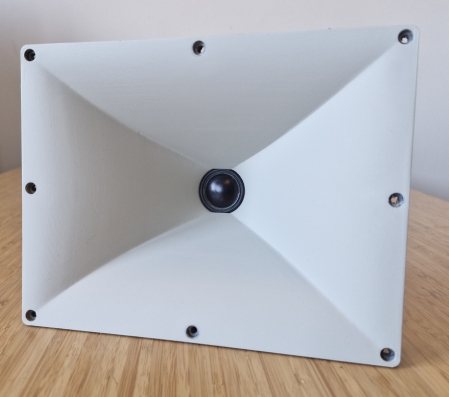PureShape, Convex wavefront with cut circular-to-rectangular transition tweeter waveguide

PureShape is our new tweeter waveguide using the SB26 ADC tweeter, designed for convex wavefront radiation without any phase plug or shield.
It uses a brand-new cut circular-to-rectangular transition, achieving constant directivity: 90° horizontal × 70° vertical.
Its horizontal coverage suits typical listening distances, and vertical directivity makes it insensitive to listening height.
The waveguide exhibits true constant directivity, free from midrange narrowing and beaming, providing a precise soundstage and immersive environment.
To order, see horn versions and prices, then contact us to proceed to payment and worldwide shipment.
Waveguide
Directivity polar plot
SPL
Below is the SPL for the 18 and 22 cm versions.
The waveguide is easy to filter, even passively, it only requires two high-shelf EQ filters: +7 dB @ 3000 Hz and +4 dB @ 7500 Hz (with the default Q = 0.707) to be corrected.
The loading effect provides more than 10 dB of sensitivity compared to direct radiation in the low end, allowing for a low crossover point with high SPL.
Distortion
Its loading capacity allows it to be used very low. Below is H3 distortion for the 18cm and 22cm version at 95dB SPL (1m), measured perfetcly flat and identical from 1kHz:
Note: The 3rd harmonic (H3) appears up to about 6.66 kHz because at that point it already corresponds to 20 kHz, thus producing an unwanted 20 kHz tone. A 3rd harmonic distortion produces an unwanted tone at three times the fundamental, 3 × 6.66 kHz = 20 kHz.
How it competes versus Direct Radiation (no WG) and Somasonus
Features
- Respects ADAPT principle (Acoustic Constant Directivity Adapted to Psychoacoustic Technology)
- Consistent Directivity: uniform sound dispersion across the listening area, eliminating midrange narrowing and beaming
- Optimized Loading: allows tweeters to operate lower and louder for balanced sound according to listening distance
- Superior Sound Control: removes diffraction and unwanted effects for a cleaner, more precise soundstage
Mounting
We recommend a round-over return of around 20mm radius on each exposed side to eliminate midrange narrowing and beaming.
Mounting is done with the baffle using M4 screws into a rebate 12 mm deep, 8 mm high, with 4 mm radius corners.
Tweeter mounting is done as show here, users has to remove the face plate but reuse the screm and put it back in place, they will serve as a centering device
The fix system with his two M4 screw is provided too.
The waveguide is 3D-printed using PLA for indoor applications or PETG-HF (price on demand) for outdoor use.
It arrives raw unless you order the spray putty service. Layers of spray putty must be applied before primer for a smooth finish, as described in our dedicated article: How to Finish my Horn.
Passive crossover
PureShape brings the tweeter back closer to the mid-woofer in depth, making delay management easier in passive filtering.
Solutions for time alignment with passive filtering (no DSP delay):
- Asymmetrical Crossover: A steeper slope can be applied to the woofer to compensate for delay, by adding one more order to the woofer’s filter.
- Mechanically Time-Aligned Design: Alternatively, our medium waveguide solution positions the mid-woofer further back, achieving proper alignment without electronic delay.
For bigger sizes X-Shape Horn with Compression Drivers are advised.











